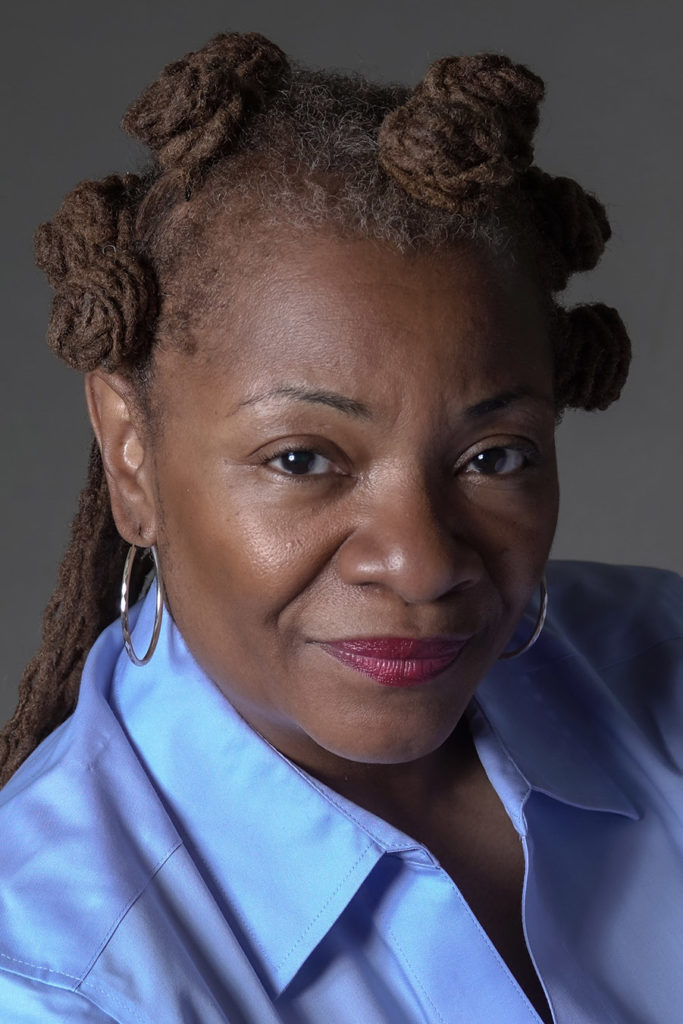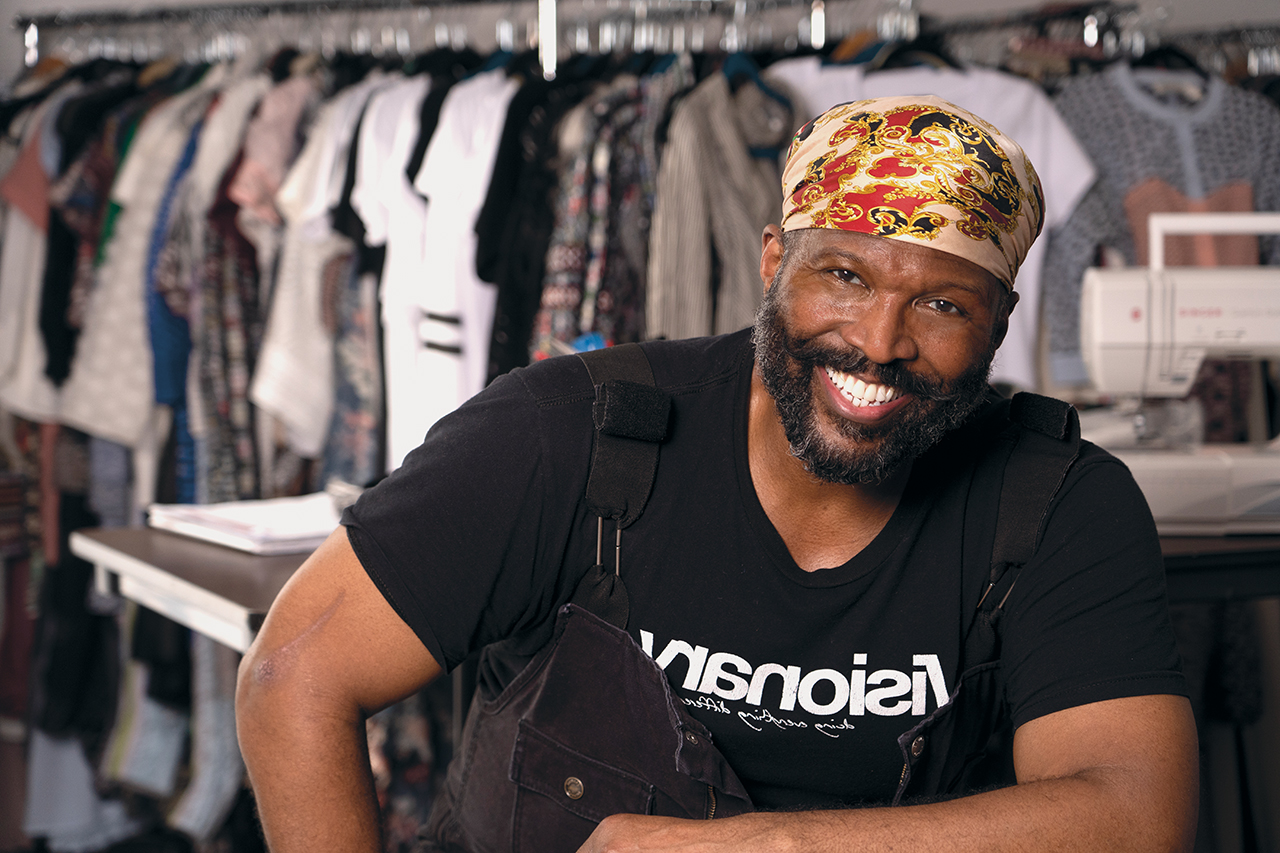

by Alex Joseph, MA ’15 with contributions from Darnell-Jamal Lisby, MA ’18
Portrait by Salimah Ali ’77
Moments into conversation, Byron Lars, the Oakland-born, San Francisco-raised designer, breaks into his signature smile, brimming with abundant warmth. He rarely seems more than a heartbeat away from a chuckle. Maybe it’s his inner Californian, but whatever the source, his infectious good mood makes you wonder. The vicissitudes of fashion have certainly affected his 30-year career. Still, when The New York Times ran a profile in 2020 titled, “Byron Lars Is Still Here,” some were puzzled. Perhaps somewhat out of sight in recent years, he was never out of the game: Michelle Obama wore Lars for the official First Family portrait, among other occasions. His Carissima dress—a lacy black sheath designed for Anthropologie—has sold 60,000 units and counting. Did we really need that reminder from the Times?
Well, yes. Though he creates styles that A-listers like Taylor Swift and Natalie Portman love, Lars has often flown under the radar. He and his business partner, Sheila Gray, Fashion Design ’04, renamed the line In Earnest last year (Earnest is his father’s middle name). Designed in their Harlem workspace, the garments are made in China, tweaked via WeChat, and sold at a bridge or higher price point in 300 specialty boutiques in the U.S., the Dominican Republic, the United Kingdom, and online.
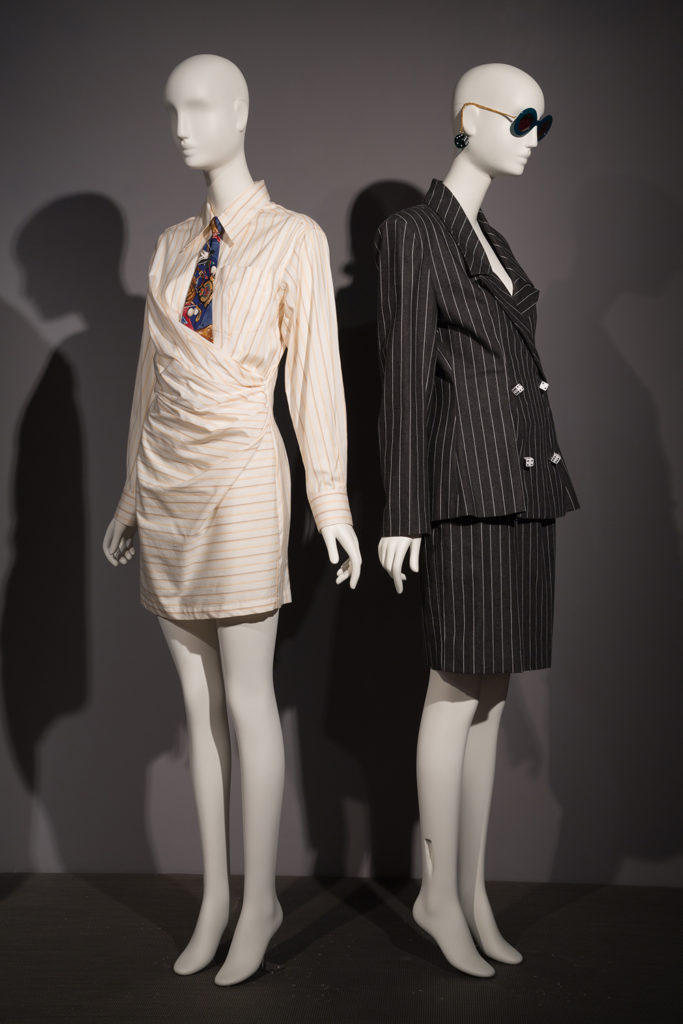
(Click on images to learn more.)
The clothes, like Lars, are exuberant—“twisted takes on American classics” is his phrase. Dresses employ densely patterned fabrics, and layer over funky pants; tracksuits are re-envisioned as elegant separates, dressy but not fussy. With stretch materials and occasional boning and other supports, these are clothes women love, whether they see the designer as a celebrity or not. “A lot of women don’t think they can wear these clothes, but they absolutely can,” he says. “[The styles] are very forgiving, even though they’re body conscious.” Angela Bassett, presenting Lars with the 2014 Pratt Fashion Visionary Award, said, “They’re clothes that make you say, ‘I’m feeling myself.’”
He made his first dress for a high school friend for prom in 1980—black, lacy, with a scooped back and an enormous silk bow for a bustle. Seeing her overjoyed and celebrating proved to be a watershed, and humbling, moment for the young designer. No outfit stands alone, he realized. “It’s not about a dress; it’s about a dress and an experience. We can’t lose sight of the practical side of design.”
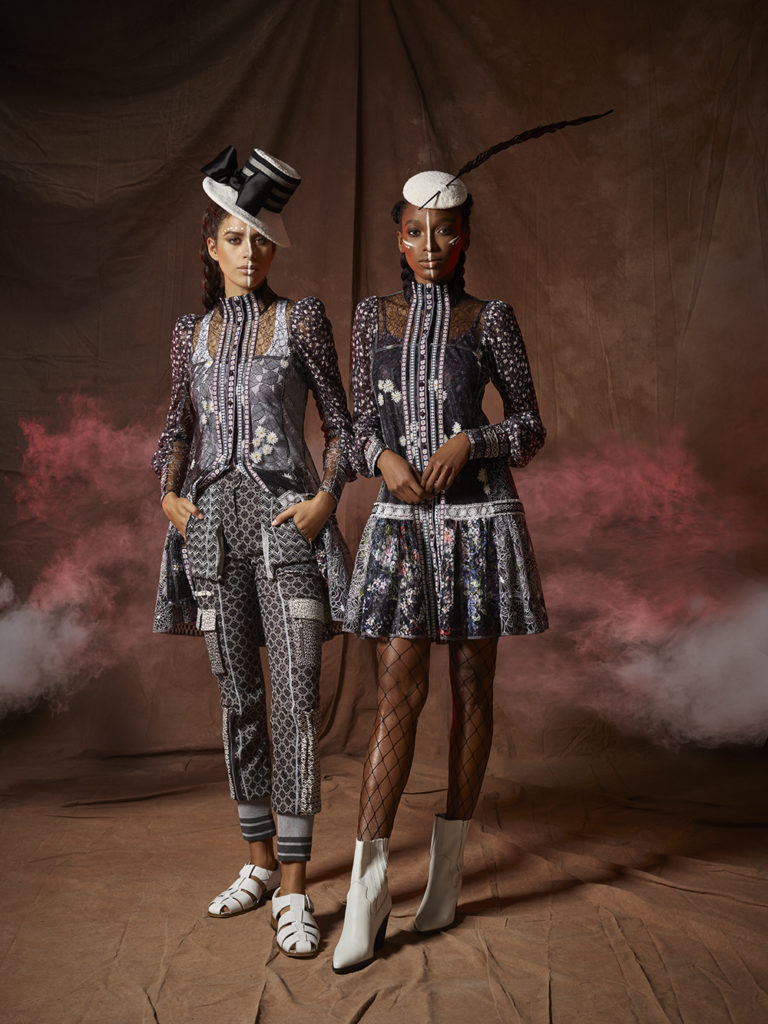
When he was looking for a college to hone his talent, one place rose to the top: FIT. “The designers and creatives that stuck out to me were Calvin Klein [’63], Norma Kamali [’65], and Antonio Lopez [’62]. I thought, people that come from this school go on to do great things, and I want some of that.” As an FIT student in the late ’80s, he visited Europe for fashion competitions (several of which he won), hoping to land a gig with Karl Lagerfeld or Christian Lacroix. No dice. Back in New York, he began circulating among various Garment Center fashion houses as an assistant designer. He developed a passion for patternmaking, but couldn’t find a home. “I got good jobs that taught me a lot and helped me start my own business, but I never got that magic job,” he says. Instead, in 1991, he made his own.

With samples of his first line, a collection of baseball jacket-inspired dresses made of duchesse satin, Lars set out to find a retailer. One of his first stops was the legendary Henri Bendel, in part because the store helped launch the career of fellow Black alum Stephen Burrows ’66. There was a recession on, and with a limited budget, Lars could only create small batches of garments. He hoped the economics would work in his favor. “They always told us in school to not start a business unless you can finance it. But I thought, in the middle of a recession, how big could the orders be?” Bendel’s wanted the styles, so Lars got to work. “From what I learned in my courses at FIT, I graded the patterns and I took them to a cutting room.” The garments were made in a factory that produced designs for a firm he had worked for, and he hand-delivered them to Bendel’s. They were featured in the store’s Fifth Avenue windows.

Lars took the samples around to publications including Harper’s Bazaar. There, he met an editor who introduced him to business consultant Mary Ann Wheaton. She knew how to launch fashion lines, having worked with Lagerfeld and noted Black designer Patrick Kelly, the first American ready-to-wear designer to be admitted to the Chambre Syndicale, the governing body of the French fashion industry. Wheaton lined up some important financing. Luxe retailer Bergdorf Goodman offered support as well. “Our first order with them, they paid 50% up front to finance the production,” Lars says. After that, his rise was meteoric. Women’s Wear Daily gave him its Rookie of the Year award, and for years he made headlines in the fashion press; then, in the mid-’90s, an important investor bailed. A designer needs backers, he realized: “No one does anything of any value alone.”
In recent years, thanks to Michelle Obama, the Anthropologie outfit, and his Barbie collaboration, Lars has maintained a certain level of visibility. He never quite scaled the heights of some other ’90s designers like Marc Jacobs or FIT alum Michael Kors. It’s hard to know whether the key factor was luck, timing … or race. The industry remains stubbornly white, despite significant achievements by Black designers. Jay Jaxon, Apparel Design ’66, was the first American to helm a Paris-based haute couture house. Burrows outshone Yves Saint Laurent at the celebrated 1973 fashion showdown Battle of Versailles. At the end of the 20th century, hip-hop mogul Sean Combs formed an influential lifestyle brand, Sean John. Still, individual Black designers struggle to make an impact.
In a recent interview with Valerie Steele, director of The Museum at FIT, Lars considered why. In the 1980s, he said, fashion entered a period in which “status and station and pedigree became valued over raw talent … and I don’t think the white fashion world could reconcile that with a Black reality.” When he launched his line, however, that issue was invisible to him: “Honestly, at the time I didn’t even think about my Blackness in relationship to my work and my place in this industry. I’m glad that I was naïve enough not to see the barriers because I don’t know how I would have reacted, or if I would have charged forth with the same joy if I thought I was in a fight.” Of course, he said, when you consider the small number of successful Black designers, the stark difference becomes apparent. He added, “The Black Lives Matter movement has already initiated some change in equity. Will it be lasting? Only time will tell.”
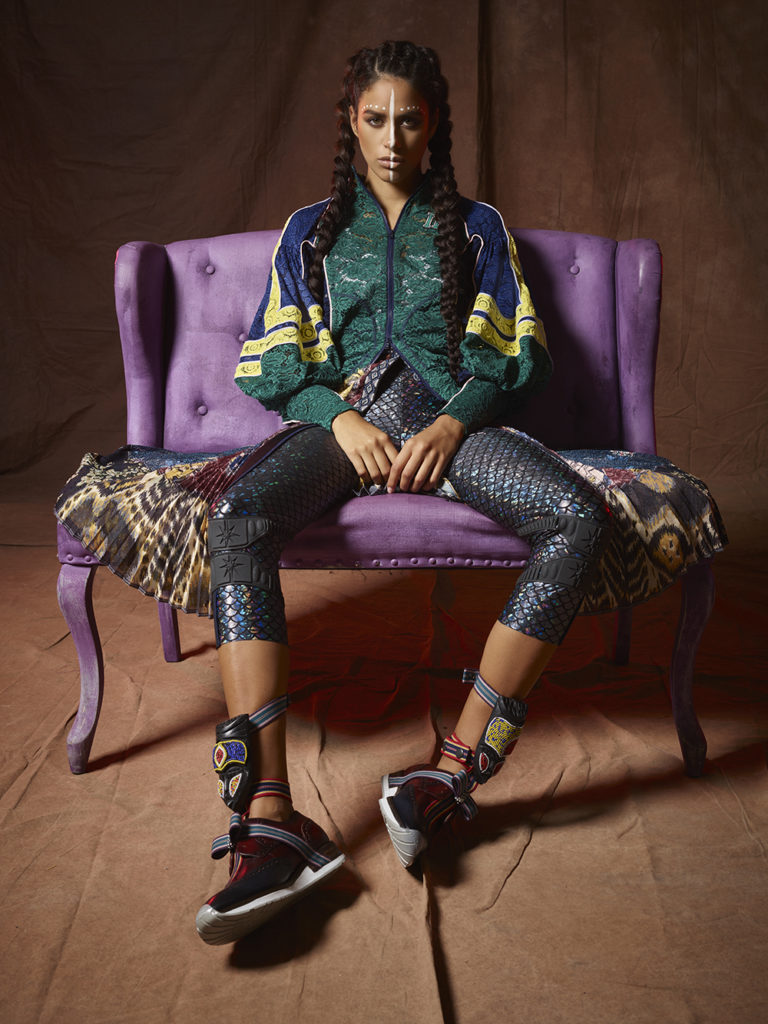
Today, Lars and Gray do the lion’s share of the work themselves. Gray even takes some of the photographs for the firm’s social media accounts, which, Lars says, is a skill in itself. “Your clothes have to speak to the customer in the digital space. Show the quality of the fabric so they can touch it with their eyes.” Designers no longer just design; they need a full set of new skills to make their presence felt—merchandising, researching fabric, even directing content. The pair are circumspect about the way fashion has treated them. Fame came, and then retreated. What remains is an earnest effort to dress women in a way their customer finds flattering—and empowering. As for the rest, Lars says, “If you’re not in it for the work, forget about it.”
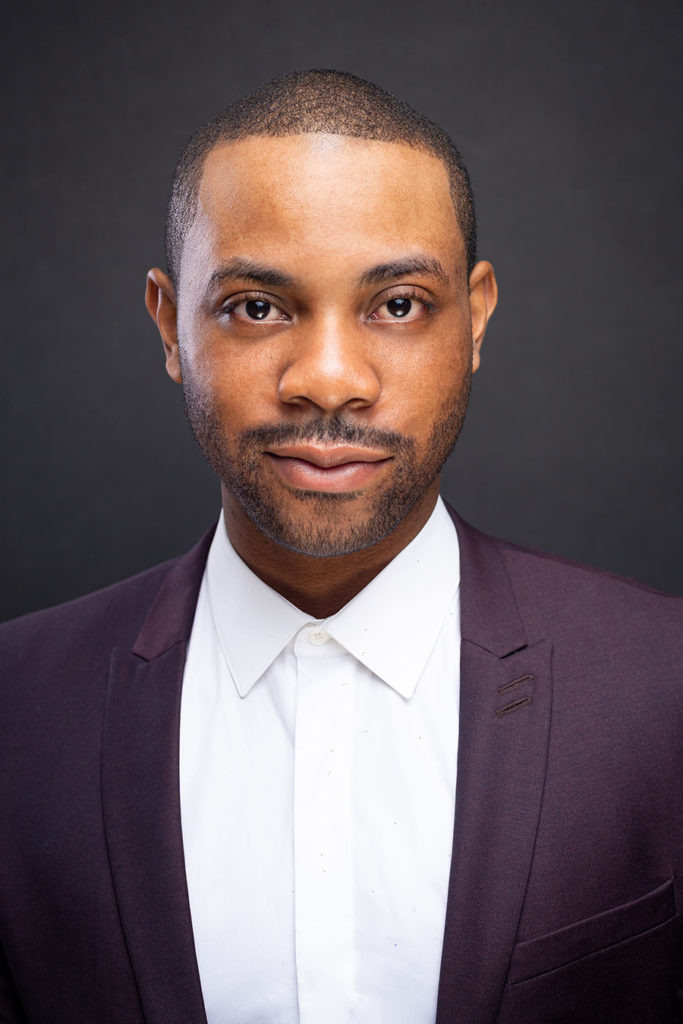
Alex Joseph, Fashion and Textile Studies: History, Theory, Museum Practice MA ’15, is a co-founder and editor of Hue. He has written for Fashion Theory, Vestoj, Fashion Studies Journal, and many other places. He now serves as chief storyteller for the college.
